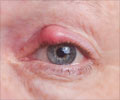A new antifungal strategy for fungal eye infection is discovered by using conjugate drug penetration to improve the efficacy and lower dosing frequency.

‘A new peptide-based antifungal strategy for Natamycin drug used in treating fungal keratitis, a fungal eye infection has been discovered.’





Fungal keratitis is the leading cause of blindness worldwide with the high incidence being reported in southern Asia and India.The currently available drugs for fungal keratitis are less effective due to poor drug penetration,poor bioavailability, and antifungal efficacy.
The drug approved by the US FDA Natamycin used in first-line treatment of fungal keratitis shows less efficacy due to poor ocular penetration requires frequent dosing.
Professor Archana Chugh, Kusuma School of Biological Sciences, IIT-Delhi said, "These peptides are known to have the ability to carry molecules with them in the cells. Therefore, when poorly permeable Natamycin was attached to the peptide, the formed complex showed better antifungal effect” .
The research study by a team of women scientists in IIT Delhi discovered that conjugate drug penetration was 5-fold higher than Natamycin in rabbits, thus enabling lowering of the dosage frequency.
Advertisement















